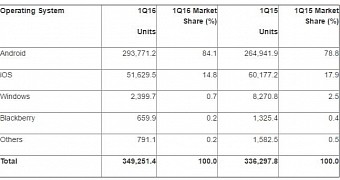Microsoft says it’s fully committed to keeping Windows phones alive, but this doesn’t seem to be enough to stop users from moving away from the platform in search of apps, better devices, and more features.
And this is exactly what is happening right now, according to Gartner, with data for the first quarter of 2016 revealing that Windows Phone dropped to 0.7 percent market share from 2.5 percent in the same quarter last year.
There are many reasons for the decline, and we won’t mention them once again here, but it’s important to note that the uncertainty regarding the future of the platform and the lack of apps are two of the factors that contributed to Windows Phone’s collapse.
Android obviously continues to be number one with 84.1 percent, followed by iOS with 14.8 percent, while BlackBerry is fourth with 0.2 percent.
If the same decline rate is maintained by Windows Phone, Microsoft’s platform can soon have the same market share as BlackBerry, a company that has migrated from its own BB OS 10 platform to Android in search of better sales. These plans, however, have produced almost no notable change in BlackBerry’s performance, so the Canadian phone manufacturer has maintained the same market share in the last few years.
Microsoft still sells four times more phones than BlackBerry
As far as Windows Phone is concerned, Microsoft sold 2.3 million handsets in the quarter, and this is still a lot as compared to BlackBerry, which shipped only 659,900 devices. By comparison, Android sold no less than 293 million units during the same period while iOS was the runner-up with 51 million.
Microsoft’s long-term mobile strategy seems to be based on just one product and on improving the platform, as the company itself offered hints that the Lumia lineup could soon go dark. The Surface Phone, due next year, is expected to be Microsoft’s revolution for the mobile industry, along with several key Windows 10 Mobile updates specifically aimed at enterprises.
And while Microsoft itself will no longer invest in more Windows 10 Mobile devices, the company hopes that partners around the world will carry on the flag, so it’s relying more on the ecosystem to make the platform succeed.
The Surface Phone is projected to see daylight in spring 2017, but since there’s no confirmation in this regard, nobody can tell for sure if this project is real or not.

 14 DAY TRIAL //
14 DAY TRIAL //